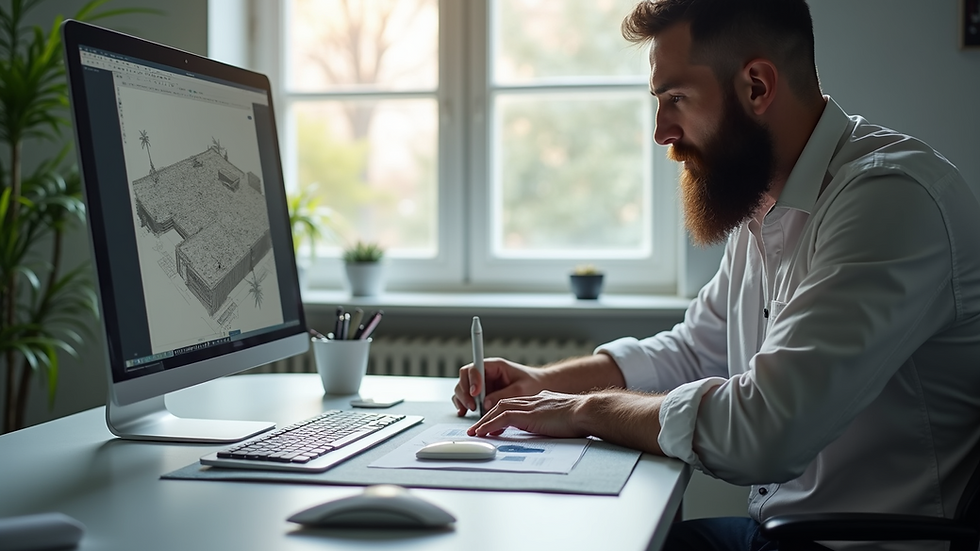How Creative Technology Shapes Modern Design
- jrobinette

- Oct 20
- 4 min read
In today’s fast-evolving world, design is no longer confined to traditional tools and methods. The integration of modern creative technology has revolutionized how designers conceive, develop, and deliver their work. This transformation has opened new avenues for innovation, efficiency, and expression. From architecture to graphic design, the impact of technology is profound and far-reaching.
The Role of Modern Creative Technology in Design
Modern creative technology refers to the advanced tools and digital platforms that empower designers to push boundaries and explore new possibilities. These technologies include 3D modeling software, virtual reality (VR), augmented reality (AR), artificial intelligence (AI), and interactive media. They enable designers to visualize concepts in immersive ways, simulate real-world scenarios, and create dynamic user experiences.
For example, architects use 3D modeling to create detailed building plans that clients can virtually walk through before construction begins. Graphic designers employ advanced automated tools to generate unique patterns and layouts quickly. These technologies not only enhance creativity but also improve accuracy and reduce project timelines.
Key benefits of modern creative technology in design:
Enhanced visualization and prototyping
Increased collaboration across teams and clients
Streamlined workflows and automation of repetitive tasks
Access to vast digital resources and inspiration
Ability to create interactive and immersive experiences

What do you mean by Creative Technology?
Creative technology is a multidisciplinary field that blends artistic creativity with technological innovation. It involves using digital tools and techniques to create new forms of art, design, and media. This approach encourages experimentation and the fusion of different disciplines such as computer science, design, and storytelling.
At its core, creative technology is about harnessing the power of technology to enhance human creativity. It can manifest in various forms, including interactive installations, digital art, immersive environments, and smart products. The goal is to create engaging and meaningful experiences that resonate with audiences on multiple levels.
For instance, museums now use AR to bring exhibits to life, allowing visitors to interact with historical artifacts in novel ways. In advertising, brands leverage AI to personalize content and deliver targeted campaigns that connect emotionally with consumers.
Examples of creative technology applications:
Interactive digital art installations
Virtual reality storytelling experiences
AI-generated music and visual content
Smart wearable devices with design aesthetics
Augmented reality apps for retail and education

How Modern Creative Technology Transforms User Experience Design
User experience (UX) design has greatly benefited from the advancements in modern creative technology. Designers now have access to tools that allow them to prototype, test, and refine user interfaces with unprecedented precision. This leads to more intuitive, accessible, and engaging digital products.
One significant transformation is the use of VR and AR in UX design. These technologies enable designers to create immersive environments where users can interact naturally with digital content. For example, an AR app can overlay product information in a real-world setting, helping customers make informed decisions.
Additionally, AI-driven analytics provide insights into user behavior, allowing designers to tailor experiences based on real data. This results in personalized interfaces that adapt to individual preferences and needs.
Practical recommendations for leveraging technology in UX design:
Use prototyping tools like Figma or Adobe XD for rapid iteration
Incorporate VR/AR to test spatial and interactive elements
Analyze user data to inform design decisions
Implement responsive design for multi-device compatibility
Focus on accessibility to ensure inclusivity

The Impact of Creative Technology on Branding and Marketing Design
Branding and marketing have also been reshaped by modern creative technology. Digital platforms and tools allow brands to craft compelling visual identities and deliver personalized messages at scale. From dynamic logos to interactive advertisements, technology enables more engaging storytelling.
For example, motion graphics and 3D animations can bring static logos to life, making brand presentations more memorable. Social media campaigns utilize automation and artificial intelligence to streamline and optimize content delivery and target specific audiences effectively. Moreover, data visualization tools help marketers communicate complex information clearly and attractively.
To stay competitive, brands should embrace these technologies and integrate them into their design strategies. This includes investing in digital content creation, exploring new media formats, and continuously analyzing campaign performance.
Tips for brands using technology in design:
Develop adaptable brand assets for various digital channels
Use video and animation to enhance storytelling
Leverage automated and advanced tools for content personalization
Monitor analytics to refine marketing strategies
Experiment with emerging technologies like AR filters
Future Trends in Modern Creative Technology and Design
The future of design is closely tied to the ongoing evolution of creative technology. Emerging trends promise to further blur the lines between the physical and digital worlds, offering exciting opportunities for designers.
Some anticipated developments include:
AI-powered design assistants that can generate concepts and automate routine tasks
Mixed reality environments combining VR and AR for seamless user experiences
Generative design where algorithms create optimized structures and visuals
Sustainable design technologies focusing on eco-friendly materials and processes
Blockchain for design rights management ensuring authenticity and ownership
Designers who stay informed and adaptable will be best positioned to leverage these innovations. Continuous learning and experimentation are essential to harness the full potential of modern creative technology.
Embracing Innovation in Design Practice
The integration of modern creative technology into design is not just a trend but a fundamental shift in how creativity is expressed and realized. By embracing these tools and approaches, designers can unlock new levels of innovation, efficiency, and impact.
Whether you are an architect, graphic designer, UX professional, or marketer, understanding and applying creative technology will enhance your work and open doors to new possibilities. Start by exploring available tools, experimenting with new techniques, and collaborating across disciplines.
This evolving landscape invites all creatives to rethink their processes and embrace the future of design with confidence and curiosity.



Comments